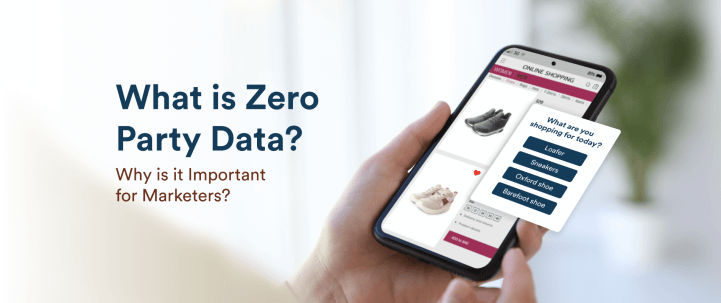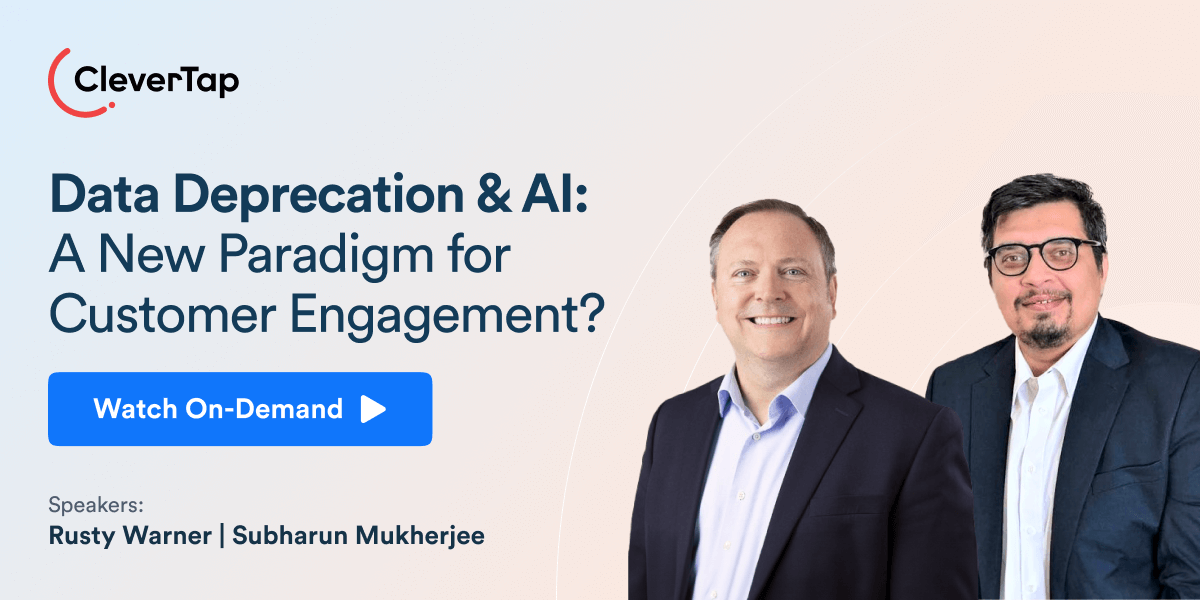Zero-party data refers to information that customers intentionally share with brands, such as preferences and feedback. This blog explores what it means, why zero-party data is gaining significance, how to collect it, and effective strategies for building a zero-party data approach to enhance customer relationships and engagement.
Zero-party data represents a valuable asset in today’s privacy-conscious digital environment. It enables more personalized, respectful, and effective interactions between brands and consumers, aligning well with the growing emphasis on transparency and data protection.
For marketers, leveraging this data can lead to more precise targeting, stronger customer relationships, and ultimately, more successful business outcomes. For product managers, it informs product development, validates concepts, improves user experience, and aids in strategic planning.
So, how are you leveraging this data effectively to create more relevant and engaging experiences, drive customer engagement, and ensure success for your business?
What is Zero-Party Data?
The term ‘zero-party data’ was originally introduced and defined by Forrester as the “data that a customer intentionally and proactively shares with a brand, which can include preference and interests, purchase intentions, personal context, and how the individual wants the brand to recognize them.” Dubbed as ‘the new oil,’ this data holds enormous potential for new forms of personalization.
Unlike first-party data (which is collected through interactions and behavior) or third-party data (collected from external sources), zero-party data is explicitly provided by the consumer with a clear understanding of how it will be used.
“When you ask customers to share zero-party data in a trust-based, privacy-focused way, and you are transparent about what you’re collecting and how you’ll use it, more customers are willing to share it.” – Rusty Warner, Vice President and Analyst, Forrester
Zero-Party Data vs. First-Party Data vs. Second-Party Data: A Quick Overview
Let’s take a quick look at the various types of data that are useful for marketers, advertisers, and product managers in building their marketing and product strategies.
First-Party Data
First-party data, also known as 1P data, refers to information collected directly from individuals who interact with your business. It includes data such as user preferences, purchase history, and interactions with your businesses’ digital properties.
For an e-commerce platform, first-party data includes tracking purchase history, browsing behavior, and customer feedback. This data enables personalized recommendations, targeted marketing, optimized user experiences, and retargeting of abandoned carts with reminders or discounts.
Second-Party Data
Second-party data is data collected by one company and shared with another company, typically through partnerships or data-sharing agreements.
For a direct-to-consumer (D2C) brand, this might involve accessing customer insights from a partnered retailer to better understand purchasing patterns and preferences, such as using data from a retailer to tailor marketing campaigns and product offerings.
Third-Party Data
Third-party data is information collected by entities outside of the direct relationship between a business and its customers, often aggregated from various sources.
For an e-commerce platform, this might involve using data from a data broker to understand broader market trends and consumer behaviors, such as acquiring demographic insights to enhance targeting strategies and optimize ad campaigns.
Zero-Party Data
This data refers to information that a customer intentionally and proactively shares with a brand. This includes data like preferences, interests, feedback, and personal context.
Why Zero-Party Data is Gaining Significance
Zero-party data is gaining significance due to its ability to provide highly accurate and direct insights into customer preferences and intentions, fostering a more personalized and transparent interaction between brands and consumers.
As privacy concerns and regulations intensify, this data stands out because it is willingly shared by customers, ensuring compliance with privacy laws and enhancing trust. This type of data enables brands to deliver more relevant experiences, improve targeting accuracy, and build stronger customer relationships, making it a crucial asset in today’s privacy-focused digital landscape.
Looking for strategies to collect zero-party and first-party data to boost customer engagement and thrive despite data deprecation? Join Rusty Warner, Vice President and Analyst at Forrester, and Subharun Mukherjee, Head of Marketing at CleverTap, as they share insights in the webinar, Data Deprecation & AI: A New Paradigm for Customer Engagement. Watch now to thrive in a data-driven world.
Benefits of Zero-Party Data for Businesses

As a marketer and product manager, how can you harness this data to gain a deeper understanding of your customers, anticipate their needs, and engage with them in real time across all channels? Let’s find out
Relevance of Zero-Party Data for Marketers
Enhanced personalization:
- Personalized Customer Experiences: Zero-party data allows marketers to create highly personalized experiences. Since this data is directly from the consumer, it provides the most accurate insights into their preferences and needs.
- For example, if a customer shares their favorite product categories, marketers can tailor email campaigns, product recommendations, and special offers to match those preferences, improving engagement and conversion rates.
Improved targeting:
- Accurate segmentation: With this data, marketers can create precise customer segments based on explicit information provided by users. This improves targeting accuracy and ensures marketing efforts reach the right audience.
- For example, a subscription service can use this data to tailor marketing campaigns for different user interests, such as fitness or cooking, leading to more effective advertising.
Increased customer trust:
- Transparent data usage: Since this data is willingly shared by consumers, its use is often seen as more transparent and respectful of privacy. This can build trust and strengthen brand loyalty.
- For example, a company that asks customers for feedback and uses it to improve products demonstrates that it values customer input, fostering trust and long-term relationships.
Compliance and Privacy:
- Regulatory advantages: With increasing privacy regulations such as General Data Protection Regulation (GDPR), The California Consumer Privacy Act (CCPA), zero-party data helps ensure compliance because it is willingly provided by the consumer, minimizing legal risks.
- For example marketers can use this data to demonstrate their commitment to privacy, thus avoiding potential legal pitfalls associated with less transparent data collection practices.
Relevance of Zero-Party Data for Product Managers
Informed product development:
- User-centric design: Zero-party data provides direct insights into customer preferences and pain points, helping product managers design and develop features that meet user needs.
- For example feedback collected through surveys can guide product managers in prioritizing features that users have explicitly requested.
Enhanced user experience:
- Personalization: By leveraging zero-party data, product managers can create personalized experiences that cater to individual user preferences, leading to a more satisfying user journey.
- For example a software application that customizes its dashboard based on user-provided preferences can offer a more intuitive and relevant experience.
Validation of product concepts:
- Market fit: Zero-party data helps product managers validate new product ideas or features before full-scale development. Direct user input can indicate whether a concept will be well-received.
- For example a company testing a new feature can use this data from user feedback to gauge interest and make adjustments before a broader rollout.
Improved roadmap planning:
- Strategic alignment: Insights from this data can inform strategic decisions and help product managers prioritize features and updates that align with user needs and preferences.
- For example data indicating a strong demand for a particular feature can lead to its inclusion in the product roadmap, ensuring alignment with user expectations.
Increased customer retention:
- Targeted enhancements: By addressing specific user needs and preferences revealed through zero-party data, product managers can enhance product features and improve customer satisfaction, leading to higher retention rates.
- For example implementing feature improvements based on user feedback can result in a product that better meets customer needs, reducing churn and increasing loyalty.
Read More: What is Database Marketing? Definition, Examples & Strategies
How to Collect Zero-Party Data
Employ the following techniques to engage with customers directly and persuade them to willingly disclose personal data:
Create surveys, polls, and gamification

Create engaging and pertinent surveys, polls, and trivia games for your intended audience. These interactive experiences capture zero-party data, often in real time, and provide value to customers by offering personalized recommendations, product suggestions, or content based on their responses. You can add features of a game to your website, app, loyalty program, or online community, such as leaderboards, badges, and points.
Here’s an example of one of the largest OTT platforms in the world, which is also a hub for global content from HBO, NBC, Paramount, and Disney. The OTT platform uses an optional, opt-out-enabled survey, designed with CleverTap’s native-display features, to enhance the in-app experience.
The survey collects user preferences on language and genre, and includes real-time gamified questions during live sports events to gauge engagement and preferences. Data such as favorite players, teams, and match predictions are integrated into customer profiles, enabling the creation of personalized, real-time experiences like leaderboards.
Contests and giveaways
Offer incentives, like prizes and contests, to entice customers to share their contact details, preferences, and interests. This helps you get important consumer data and creates buzz about your business.
Personalized email campaigns
Send out segmented email marketing to customers according to their interests or preferences. You can collect zero-party data and improve personalization by giving customers the choice to select the content, products, or services that they like.
Social media engagement
Create polls, quizzes, and surveys on social media sites to provide your consumers engaging experiences while striving to learn about their preferences. It will allow you to develop your social media presence in addition to building your zero-party data.
Customer feedback
Ask for reviews, testimonials, or ratings from customers and provide incentives for their participation. By learning about the preferences and areas of struggle from their consumers, as well as hearing about both positive and bad experiences, businesses can make better decisions and enhance their offers.
CleverTap’s Zero-Party Data Security
As data deprecation becomes a reality, novel solutions of data collection and storage will become necessary. Does this mean brands will now need to invest in additional technologies? Not necessarily.
While there are multiple point solutions in the market addressing use cases related to zero-party data collection and storage, brands should check-in with their partners to identify means of scaling their existing tech investments for the newer requirements.
A customer data platform serves as a central source of first-party data. It combines information from various tools, such as email, analytics, CRM, e-commerce, and social media. This platform ensures consumer privacy and compliance with regulations by managing data flows between marketing systems and overseeing consent. It also facilitates audience segmentation, helping create personalized customer experiences.
In fact, businesses can leverage the existing infra of CDPs, at no additional cost to collect zero-party data by orchestrating surveys, games contests from existing infra and store that information.
Building a Zero-Party Data Strategy

Here’s your guide to building a zero-party data strategy.
Define your objectives
- Identify goals: Understand what you want to achieve with Zero-Party Data. This could be improving personalization, enhancing customer experience, or refining product offerings.
- Align with business needs: Ensure your objectives align with broader business goals and customer expectations.
Choose the right data collection methods
- Surveys and feedback forms: Create surveys or feedback forms asking for specific preferences or opinions.
- Interactive content: Use quizzes, polls, and interactive tools to gather information.
- Personalization forms: Implement forms where customers can specify their preferences for product recommendations or communication.
Design a user-friendly experience
- Transparency: Clearly explain why you’re asking for data and how it will be used. Ensure customers understand the benefits to them.
- Ease of use: Make data collection forms and tools easy to use and navigate. Avoid lengthy or complex processes.
- Incentives: Offer rewards or incentives for sharing information, like discounts or exclusive content.
Implement data collection tools
- CRM systems: Use Customer Relationship Management (CRM) systems to collect, store, and manage zero-party data.
- Data management platforms: Leverage data management platforms to integrate and analyze this data alongside other data types.
- Privacy management tools: Ensure compliance with privacy regulations (e.g., GDPR, CCPA) using appropriate tools and practices.
Analyze and utilize data
- Segmentation: Segment your audience based on the zero-party data collected to tailor marketing strategies and communications.
- Personalization: Use the data to personalize customer interactions, product recommendations, and marketing campaigns.
- Insights: Analyze the data to gain insights into customer preferences and behavior.
Build trust and maintain privacy
- Data Protection: Ensure strong data security measures to protect customer information.
- Respect Preferences: Honor the preferences and choices customers make about how their data is used.
- Compliance: Stay compliant with data protection regulations and update your practices as laws evolve.
Monitor and iterate
- Feedback Loop: Regularly collect feedback on how customers feel about your data collection practices and make improvements as needed.
- Performance Metrics: Track the effectiveness of your zero-party data strategy in achieving your goals.
- Adapt: Continuously adapt your approach based on data analysis and customer feedback.
Communicate with your customers
- Updates: Keep customers informed about how their data is being used and any changes in your data practices.
- Engagement: Engage with customers to encourage ongoing data sharing and feedback.
By focusing on these steps, you can build a zero-party data strategy that not only enhances your marketing and customer experience but also builds trust and loyalty with your audience.
In conclusion, Zero-Party Data stands out as a valuable asset in today’s data-driven landscape. By directly capturing customer preferences and intentions, it provides unparalleled accuracy and relevance, leading to more effective and personalized marketing strategies. Moreover, it fosters trust and transparency between brands and consumers, enhancing customer relationships. Embracing Zero-Party Data not only helps in crafting targeted experiences but also aligns with evolving privacy standards, making it an essential component of a modern data strategy.
Divya Ojasvi Sharma 
Divya is a communications professional with extensive experience in content writing, content creation and strategies, and social media management.
Free Customer Engagement Guides
Join our newsletter for actionable tips and proven strategies to grow your business and engage your customers.















































